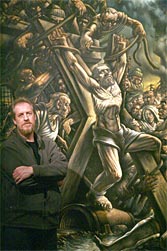
Peter Howson and his latest work
The Crucifixion of St Andrew
Neil Davidson Archive | ETOL Main Page
From Socialist Worker, No. 2033, 13 January 2007.
Copied from the Socialist Worker Website.
Marked up by Einde O’Callaghan for the Encyclopaedia of Trotskyism On-Line (ETOL).
Neil Davidson fails to be converted by Peter Howson’s religiously inspired work

|
|
Peter Howson and his latest work |
According to the New Testament, St Andrew was the first disciple to be called by Jesus Christ. He was later executed by the Romans at Patras in present day Greece on the X-shaped cross which now bears his name.
A new exhibition of 80 paintings and drawings by artist Peter Howson, dealing mainly with Andrew’s death, opened on St Andrew’s Day (30 November) in the Edinburgh City Art Centre.
It takes place against the background of the Scottish Parliament voting to make 30 November a national holiday – although in typical New Labour style, only by substituting it for an existing one.
It may not be immediately obvious why a 1st century Jewish Christian martyr is Scotland’s patron saint. According to legend, Bishop Regulus of Patras fled during the 4th century with Andrew’s relics. He was supposedly shipwrecked on the coast of Fife, where the town and university called after St Andrew now stand.
Andrew only became important in Scottish history much later. His cross was adopted as the official seal of Scottish government in 1286 as a unifying symbol for the medieval monarchy, immediately before the wars against England for an independent feudal kingdom began.
The Reformation of 1560 was responsible for destroying most of the iconography of Catholic Scotland, but representations of St Andrew had little popular significance in the first place.
As the exhibition’s programme points out, Howson’s paintings of St Andrew’s martyrdom are without precedent in Scotland. So why the renewal of interest in a quasi-mythical figure who never set foot in the country?
For Labour MSPs, this is an opportunity to emphasise their Scottishness at no political cost and thus deflect Scottish National Party accusations that they lack patriotism. For Howson, however, the issue is more complex.
Howson was one of the so-called New Glasgow Boys, a group of mainly figurative artists that emerged in the mid-1980s and included Ken Currie and Stephen Campbell. Howson’s representations of the human form are monumental, grotesquely muscular and – regardless of the supposed gender involved – invariably masculine.
The style is at any rate distinctive, whatever one thinks of it. So too is his subject matter, a Scotland populated by down-and-outs, drunks, prostitutes and men either on the edge of violence or actually engaged it.
As an antidote to both shallow boosterism about the “New Scotland” and the moral vacuity of most “Brit-art”, this has some attractions. But the pleasures of negative critique apart, Howson’s work is problematic in terms of both form and content.
Monstrous though Howson’s figures are, his approach is highly conventional. And having established a style, Howson works it to death, repeating but never developing.
The current exhibition has one central work, The Crucifixion of St Andrew, but much of the rest is taken up with preparatory studies and sketches, which are often more interesting than the paintings – some of the pen and ink “studies for Saint Andrew”, for example, recall Picasso’s later work.
The most convincing works here are the handful of paintings of the faces of his main protagonists. These show Howson at his best, not least because they exclude the portentous clutter of the major canvasses.
Taken in the context of his work as a whole, The Crucifixion itself resembles the latest instalment of a plotless graphic novel about the aftermath of the apocalypse – although this apocalypse is a spiritual absence, a moral wilderness, rather than the result of war or environmental collapse.
Howson announced his religious conversion in 2003. His figures still wander through the same landscapes of desolation, but now with the added miraculous ingredient (so to speak) of Christian salvation.
Howson has described himself as being influenced by 19th century visionary William Blake. But the comparison relies on fairly superficial parallels in the way both artists represent the body.
Blake’s highly personalised but revolutionary mysticism involved a celebration of the human physicality (“the naked female form divine”) and the god-given potential of human beings to transform their world.
In contrast, the ugly swarming masses that populate Howson’s paintings are lost in a collective darkness and cannot save themselves – they need to be saved by the sacrificial example of the martyred saint.
Given the current controversies over religion, the question of how to represent faith in the arts – and not only the visual arts – is likely to become more pressing in the coming years.
Howson’s most recent work demonstrates, if nothing else, that the solution is unlikely to be found simply by representing saints transplanted into the landscapes of capitalist modernity.
Peter Howson’s exhibition is at Edinburgh City Art Centre, Market Street, until 4 March. Go to www.howsonworks.com for more details.
Neil Davidson Archive | ETOL Main Page
Last updated: 22 May 2021